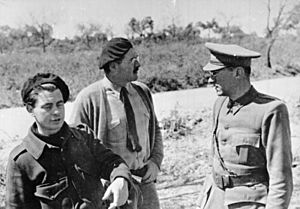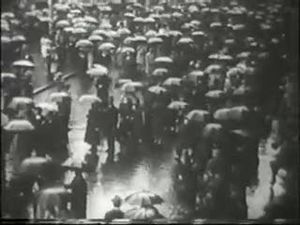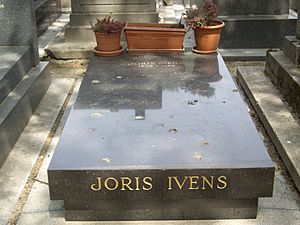Joris Ivens facts for kids
Quick facts for kids
Joris Ivens
|
|
|---|---|

Joris Ivens, circa 1971
|
|
| Born |
Georg Henri Anton Ivens
18 November 1898 Nijmegen, Netherlands
|
| Died | 28 June 1989 (aged 90) Paris, France
|
| Occupation | Film maker |
| Spouse(s) | Marceline Loridan-Ivens |

Georg Henri Anton "Joris" Ivens (born November 18, 1898 – died June 28, 1989) was a famous Dutch filmmaker. He made many important documentary films. Documentaries are films that show real life and real events.
Some of his well-known films include A Tale of the Wind, The Spanish Earth, and Rain. He also directed Misère au Borinage (about coal miners) and 17th Parallel: Vietnam in War (about the Vietnam War). Joris Ivens traveled the world to make his films. He wanted to show people what was happening in different places.
Contents
Early Life and Film Beginnings
Joris Ivens was born into a rich family. His father owned shops that sold photo supplies. Joris started working in one of these shops. This is where he first became interested in making films. He even made his first film when he was just 13 years old!
Later, he studied economics in college. He thought he would take over his father's business. But he became more interested in social issues and how different groups of people lived. In 1923, he met a photographer named Germaine Krull. They had a special kind of marriage from 1927 to 1943. This helped Germaine get a Dutch passport and seem more settled, without changing her independent life.
At first, Joris Ivens focused on how films were made. He paid attention to the camera work and editing. You can see this in his early films like Rain (1929) and The Bridge (1928). Rain was a short film that took two years to make!
Around this time, he helped create the Dutch Film League in Amsterdam. This group brought famous filmmakers from other countries to the Netherlands. People like Sergei Eisenstein and Dziga Vertov became his friends.
In 1929, Ivens visited the Soviet Union. He was asked to make a film about anything he wanted. He chose to film a new industrial city called Magnitogorsk. Before that, he made a film called Industrial Symphony for Philips Electric. This film is known for its beautiful technical style. He then returned to the Soviet Union. There, he made Song of Heroes in 1931. This film was about the new industrial city. It showed many workers and young communists working for Stalin's big plan. This was a propaganda film, meaning it was made to support a certain political idea.
With Henri Storck, Ivens made Misère au Borinage (1933). This documentary showed the difficult lives of coal miners. In 1943, he also directed two films for the National Film Board of Canada. These were propaganda films for the Allies during World War II. One was called Action Stations. It was about the Royal Canadian Navy protecting ships during the Battle of the Atlantic.
Working in the U.S. and During World War II
From 1936 to 1945, Joris Ivens lived in the United States. In 1940, he made a documentary called Power and the Land. It was about bringing electricity to farms. The film showed a family, the Parkinsons, and how electricity helped their farm.
Ivens was known for his films that were against fascism. Fascism is a type of government where a single leader has total control and often uses force. One of his most famous anti-fascist films was The Spanish Earth. This film supported the Republicans during the Spanish civil war. Famous writer Ernest Hemingway helped write the film. Many Hollywood stars and writers helped pay for it. This film was shown at the White House in 1937. President Franklin D. Roosevelt and his wife Eleanor Roosevelt watched it. They really liked the film. Many people thought The Spanish Earth was his best work.
In 1938, he traveled to China. He made The 400 Million (1939). This film showed the history of modern China. It also showed the Chinese fighting against Japan during the Second Sino-Japanese War. The famous photographer Robert Capa worked on this film.
In 1943, Joris Ivens was hired by Frank Capra. Capra was making a film series for the U.S. War Department called Why We Fight. Ivens was supposed to help with a film called Know Your Enemy: Japan. But Capra fired him. Capra felt that Ivens's ideas for the film were too kind to the Japanese.
Because of his political views, Ivens had to leave the United States in the late 1940s. This was during a time called the "Red Scare." During this period, many people in the U.S. were afraid of communism.
Return to Europe and Later Years
In 1946, Joris Ivens was asked to make a film about Indonesia becoming independent from the Netherlands. But he quit the project. He felt that the Dutch were still trying to control Indonesia. Instead, Ivens secretly filmed Indonesia Calling. This film supported Indonesia's independence.
For about ten years, Ivens lived in Eastern Europe. He worked for several film studios there. The Dutch government was not happy with his views on Indonesia. They also didn't like that he supported the Eastern Bloc during the Cold War. Because of this, he had to renew his passport very often.
From 1965 to 1970, he made two documentaries about North Vietnam during the war. These were 17th Parallel: Vietnam in War and Far from Vietnam. In 1967, he received the Lenin Peace Prize. This was a big award given by the Soviet Union for promoting peace.
From 1971 to 1977, he made a very long documentary called How Yukong Moved the Mountains. This film was about the Cultural Revolution in China. He was allowed to film almost anywhere. This was because he supported communism and was friends with Chinese leaders like Zhou Enlai and Mao Zedong.
In 1988, Joris Ivens received the Golden Lion Honorary Award at the Venice Film Festival. This is a very important award in the film world. In January 1989, he received another honor, the Order of the Netherlands Lion. He passed away on June 28, 1989. Just before he died, he released his last film, A Tale of the Wind. In 2010, a statue of Joris Ivens was put up in Paris.
Filmography
- The Flaming Arrow (1912)
- O, Sunland (1922)
- The Sunhouse (1925)
- Film Sketchbook (1927)
- The Sick Town (1927)
- Instruction Films Micro Camera, University Leiden (1927)
- Movement Studies in Paris (1927)
- Filmstudy Zeedijk (1927)
- The Street (1927)
- Ice Skating (1927)
- The Bridge (1928)
- Rain (1929)
- Breakers (1929)
- Poor Drenthe (The Misery in the Peat-mores of Drenthe) (1929)
- Pile Diving (1929)
- Zonneland (1930)
- We are building (1930)
- Second Union Film (1930)
- Zuiderzee (1930)
- Tribune Film (1930)
- Concrete Construction (1930)
- Donogoo-Tonka (1931)
- Philips Radio (1931)
- Creosote (1932)
- Komsomol, (Song of Heroes, Youth Speaks) (1932)
- New Earth (1933)
- Borinage (1934)
- The Spanish Earth (1937)
- The 400 Million (1938)
- New Frontiers (1940)
- Power and the Land (1940)
- Our Russian Front (1942)
- Action Stations (1943)
- Corvette Port Arthur (1943)
- Know Your Enemy: Japan (1945) (uncredited)
- Indonesia Calling (1946)
- The First Years (1948)
- Friendship Triumphs (1952)
- Peace Tour 1952 (1952)
- Chagall (article in Italian) (1952-1960)
- The Song of the Rivers (1954)
- My Child (1956)
- The Windrose / Rose of the Winds (1957)
- The war of the 600 Million People (1958)
- Letters from China (1958)
- L'Italia non è un paese povero (article in Italian) (1960)
- Demain à Nanguila (1960)
- Carnet de viaje (1961)
- Pueblo en armas (1961)
- Le petit chapiteau (1963)
- Le train de la victoire (1964)
- ...A Valparaiso (article in French) (1965)
- Le mistral (1965)
- Rotterdam Europoort (1966)
- Le ciel - La terre (1967)
- Far from Vietnam (1967)
- Une histoire de ballon (1967)
- 17th Parallel: Vietnam in War (1968)
- Le people et ses fusills (1970)
- How Yukong Moved the Mountains (1976)
- Les ouigours (1977)
- Les Kazaks (1977)
- The Drugstore (1980)
- A Tale of the Wind (1988)
See also
 In Spanish: Joris Ivens para niños
In Spanish: Joris Ivens para niños




